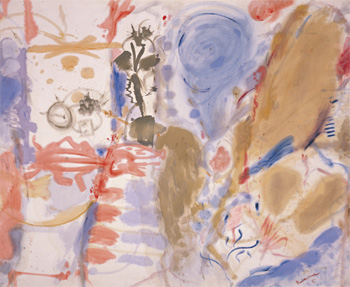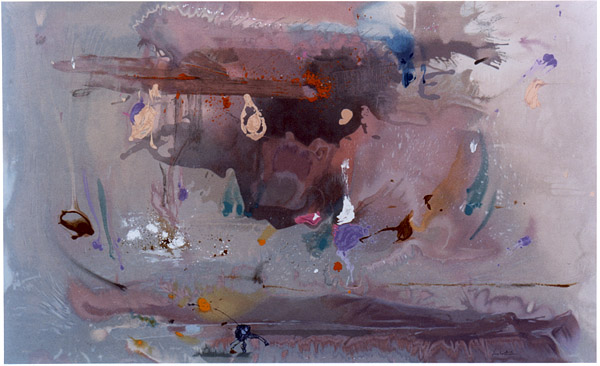 I commend your attention to “Frankenthaler at 80: Six Decades,” which goes up at Knoedler & Company tomorrow and will be on view there through January 10. Here’s part of the press release:
I commend your attention to “Frankenthaler at 80: Six Decades,” which goes up at Knoedler & Company tomorrow and will be on view there through January 10. Here’s part of the press release:
Helen Frankenthaler, eminent among American abstract painters, will be eighty in December 2008. To celebrate her landmark birthday, Knoedler & Company is pleased to present this survey exhibition of major paintings spanning Frankenthaler’s entire career, from the 1950s to the 2000s. The show can be described as by, with, and from Frankenthaler. The selection has been made by the exhibition’s curator, Karen Wilkin, in consultation with the artist, from paintings that, until now, she has retained as part of her personal collection of her own work….
I got an advance peek at “Frankenthaler at 80” yesterday afternoon, and found it altogether remarkable. The show consists of nine works painted between 1957 and 2002, none of them small and one, “A Green Thought in a Green Shade,” very large. It isn’t easy to suggest Frankenthaler’s stylistic range in so compact an exhibition, but this one gets the job done with room to spare.
The accompanying catalogue, not at all surprisingly, is a superior piece of work. Karen Wilkin ranks very high on the short list of my favorite art critics, living or dead, and what she doesn’t know about Helen Frankenthaler probably isn’t so. Her essay makes a special point of praising Frankenthaler for her variety and unpredictability:
No matter what the mood, temperature, or even source of her paintings, she has never been a systematic explorer of material or formal possibilities. Unlike many of her colleagues, who habitually tested their ideas about chroma, interval, edge, and scale through intuition-driven themes and variations, she has never worked in series. There may be broad connections among groups of pictures made at about the same time, but each work has been “worried”–as Frankenthaler puts it–out of real experience….
We categorize Frankenthaler at our peril. Describe her as a master of radiant, uninhibited color relationships and she presents us with dark, brooding images, luminous monochromes, or pale, light-struck compositions devoid of chromatic color. Call her a radical innovator and we discover that, throughout her evolution, she has been engaged in a dialogue with the art of the past. Assign her to the ranks of uncompromising abstract painters and we notice that she is preternaturally attentive to the nuances of her surroundings, whether at home or abroad.
 It happens that Helen Frankenthaler is my favorite living painter, and the passage quoted above goes a long way toward explaining why, though I’d add one thing: she is one of the most enjoyable of the great American modernists, a painter who is unafraid to give pleasure and secure in the knowledge that to do so is a legitimate goal of modern art. Her work has been giving me intense and lasting pleasure ever since I started looking at paintings, and I’d surely write about this gorgeous show in The Wall Street Journal were I not the fortunate owner of one of her prints, “Grey Fireworks,” which hangs over the couch in my Upper West Side living room and of which Mrs. T and I are sinfully proud.
It happens that Helen Frankenthaler is my favorite living painter, and the passage quoted above goes a long way toward explaining why, though I’d add one thing: she is one of the most enjoyable of the great American modernists, a painter who is unafraid to give pleasure and secure in the knowledge that to do so is a legitimate goal of modern art. Her work has been giving me intense and lasting pleasure ever since I started looking at paintings, and I’d surely write about this gorgeous show in The Wall Street Journal were I not the fortunate owner of one of her prints, “Grey Fireworks,” which hangs over the couch in my Upper West Side living room and of which Mrs. T and I are sinfully proud.
Instead of holding forth at length about Frankenthaler’s virtues, I’ll simply urge you to go see “Frankenthaler at 80” for yourself. As for me, I can’t wait to see it again.
